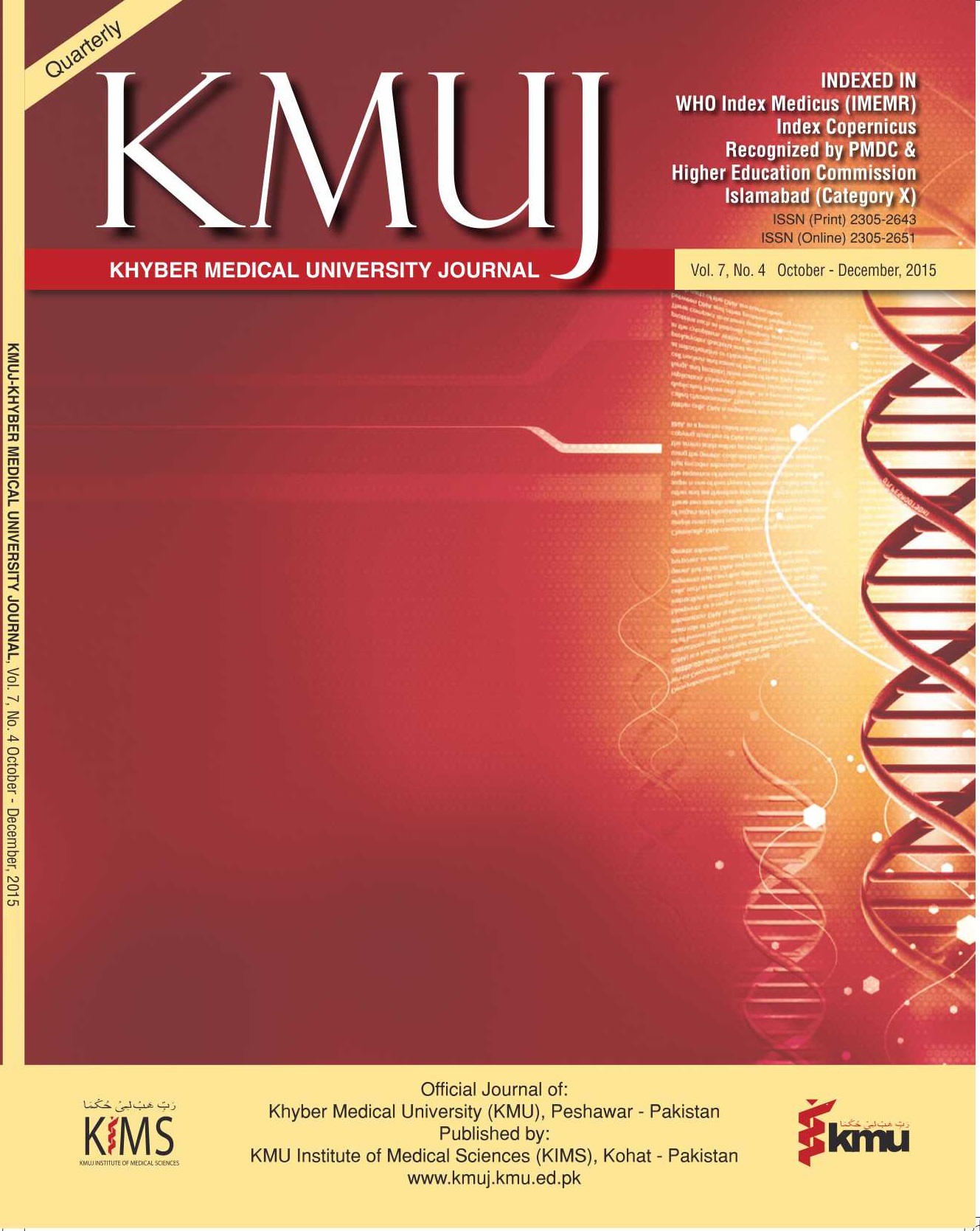FREQUENCY AND ANTIBIOTIC SUSCEPTIBILITY PATTERN OF METHICILLIN RESISTANT STAPHYLOCOCCUS AUREUS IN ABBOTTABAD CITY OF PAKISTAN
Main Article Content
Abstract
Objectives: to establish the frequency of methicillin resistance among the isolates of Staphylococcus aureus and pattern of antimicrobial susceptibility of methicillin resistant Staphylococcus aureus (MRSA) isolates to the commonly prescribed antibiotics in Abbottabad.
METHODS: This cross-sectional, descriptive study was conducted
at Ayub Teaching Hospital, Abbottabad, Pakistan, from 2007 to 2010.
Clinical samples from pus, urine and other specimens were inoculated
on Nutrient agar, MacConkey agar, and Blood agar and a questionnaire
was used to collect the necessary information about the patient. Staphylococcus aureus was identified by standard microbiological procedures. Disc diffusion test and MIC were used to test the susceptibility of S.aureus isolates according to the guidelines of Clinical Laboratory Standards Institute (CLSI, 2009).
RESULTS: Out of 98 S. Aureus isolates, 24 (24.49%) were recognized
as MRSA. Out of 24 MRSA isolates, 17 (70.83%) & 5 (20.83%) were
isolated from pus and urine respectively. S. aureus was highly sensitive to imipenem but resistant to amoxycillin (100%), and 1st and 3rd generation cephalosporins i.e., ceftazidime (75.51%), cefaclor (65.31%), and cephradine (60.2%). Twenty four (24.49%) S. aureus isolates were found to be MRSA and 74 (75.51%) were methicillin sensitive Staphylococcus aureus (MSSA). Among MSSA, 37.84% were found to be multi drug resistant (MDR). All the 24 MRSA were also found to be MDR.
CONCLUSION: Frequency of MRSA is quite common in patients from
Abbottabad and these MRSA are highly resistant to commonly prescribed antibiotics. Due to high resistance of S. aureus to antibiotics, appropriate use of anti-staphylococcal antibiotics is essential.
Article Details
Work published in KMUJ is licensed under a
Creative Commons Attribution 4.0 License
Authors are permitted and encouraged to post their work online (e.g., in institutional repositories or on their website) prior to and during the submission process, as it can lead to productive exchanges, as well as earlier and greater citation of published work.
(e.g., in institutional repositories or on their website) prior to and during the submission process, as it can lead to productive exchanges, as well as earlier and greater citation of published work.
References
References
Enright MC, Robinson DA, Randle G, Feil
EJ, Grundmann H, Spratt BG. The evolutionary
history of methicillin-resistant
Staphylococcus aureus (MRSA). Proc Natl
Acad Sci 2002; 99(11): 7687-92.
Marlowe EM, Bankowski MJ. Conventional
and molecular methods for the detection
of methicillin-resistant Staphylococcus
aureus. J Clin Microbiol 2011; 49(9 Suppl):
S53-S6.
Naqvi ZA, Hashmi K, Kharal SA. Methicillin
resistant Staphylococcus aureus (MRSA)
in burn patients. Pak J Pharmacol 2007;
(2): 7-11.
Sabir R, Alvi SFD, Fawwad A. Antimicrobial
susceptibility pattern of aerobic
microbial isolates in a clinical laboratory
in Karachi-Pakistan. Pak J Med Sci 2013;
(3): 851.
Hussain S, Shams R, Ahmad K, Perveen R,
Riaz B. Prevalence of Methicillin Resistant
Staphylococcus Aureus (MRSA) in surgical
site infections in a tertiary care hospital. Int
J Pathol 2005; 3(2): 81-5.
Khan S, Rasheed F, Zahra R. Genetic
polymorphism of agr Locus and antibiotic
resistance of Staphylococcus aureus at
two hospitals in Pakistan. Pak J Med Sci
; 30(1): 172.
Bukhari SZ, Ahmed S, Zia N. Antimicrobial
susceptibility pattern of Staphylococcus
aureus on clinical isolates and efficacy
of laboratory tests to diagnose MRSA:
A multi-centre study. J Ayub Med Coll
Abbottabad 2011; 23(1): 139-42.
Chaudary S, Qureshi M, Haroon S. Prevalence
of MRSA in a peripheral hospital of
Lahore. Biomedica 2011; 27: 24-5.
Costelloe C, Metcalfe C, Lovering A, Mant
D, Hay AD. Effect of antibiotic prescribing
in primary care on antimicrobial resistance
in individual patients: systematic review
and meta-analysis. BMJ 2010; 340: c2096.
Blanc D, Lugeon C, Wenger A, Siegrist H,
Francioli P. Quantitative antibiogram typing
using inhibition zone diameters compared
with ribotyping for epidemiological typing
of methicillin-resistant Staphylococcus
aureus. J Clin Microbiol 1994; 32(10):
-9.
Cheesbrough M. District laboratory
practice in tropical countries: Cambridge
university press; 2006.
Wayne P. National committee for clinical
laboratory standards. Performance standards
for antimicrobial disc susceptibility
testing. 2002; 12.
Magiorakos AP, Srinivasan A, Carey R,
Carmeli Y, Falagas M, Giske C, et al. Multidrug-
resistant, extensively drug-resistant
and pandrug-resistant bacteria: an international
expert proposal for interim standard
definitions for acquired resistance. Clin
Microbiol Infect 2012; 18(3): 268-81.
Smith TL, Pearson ML, Wilcox KR, Cruz
C, Lancaster MV, Robinson-Dunn B, et
al. Emergence of vancomycin resistance
in Staphylococcus aureus. N Engl J Med
; 340(7): 493-501.
Hussain M, Basit A, Khan A, Rahim K, Javed
A, Junaid A, et al. Antimicrobial Sensitivity
Pattern of Methicillin Resistant Staphylococcus
aureus Isolated from Hospitals
of Kohat District, Pakistan. J Inf Mol Biol
; 1: 13-6.
Rahman S, Mumtaz S, Mufti AJ, Shah SH,
Rahman M. Incidence of methicillin resistant
Staphylococcus aureus in Peshawar. J
Ayub Med Coll Abbottabad 2011; 23(1):
-101.
